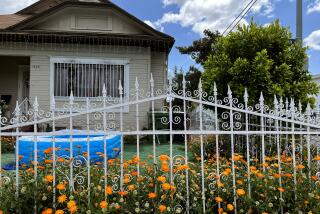Once More, Into the Suburbs
SUISUN CITY — As a kid in Fresno, I got to witness a great battle in the war on suburban sprawl. A famous Viennese architect named Victor Gruen was recruited to save downtown from the subdivisions spreading north like Bermuda grass--in essence, taking the town with them. “The anti-city,” Gruen called them.
His idea was to reverse the pattern, to return Fresno to its “heart.” He convinced city officials to convert the main downtown street into a long outdoor mall, banishing the automobile to create a “pedestrian reserve” where Fresnans could shop, dine and commune. Later, as the heart beat stronger, the mall was to be surrounded with new residential neighborhoods and other civic adornments. The suburban beast would be slain.
It was a wonderful plan.
Urban architects came from everywhere to admire Gruen’s vision; hundreds of small cities across the land leaped to copy the concept. Unfortunately, it failed. One reason it failed was that, early on, politicians strayed from the plan, forgoing such vital elements as downtown housing and allowing developers to build an indoor mall in the suburban north. In addition, a whole lot of Fresnans seemed to prefer life in the suburban anti-city. They liked big yards, safe streets, good schools, even three-car garages--at least that’s what they kept buying, not that the developers gave them much choice.
Today Fresno keeps leaping forever northward, while the Fulton Mall lingers behind, forgotten. Today urban theorists no longer flock to Fresno or rhapsodize about “pedestrian reserves.” Instead, the current hope among would-be suburb slayers is a movement called “the New Urbanism,” which takes us right here to Suisun City, (pop. 26,000), a little delta town midway between San Francisco and Sacramento.
*
As he drove around town the other day, showing off the wonders that have so excited the urban planning world, Mayor Jim Spering conceded that architectural trend-setting has not exactly dominated his concerns. “We’re just trying to build a community,” he said. Given the shape of things when he was elected in the late 1980s, this would seem to be challenge enough.
For starters, at the heart of Suisun was a notorious slum where daylight drug deals were common. The town marina was sinking, the water too silted for safe navigation. City Hall consisted of three trailers--perhaps the only civic center in California registered with the DMV. The skyline was dominated by 40 large oil tanks at town center.
Today, all that is changing. The growls and beeps of construction equipment can be heard all over town. Already, there is a new Civic Center, white and airy and topped with a graceful dome. There is a new town plaza, a new marina, a new train station--all designed to evoke an old-time village. The slum has been replaced by a neighborhood of modestly priced homes--handsome wooden structures painted in pretty pastels and built in a style an architect called “working-class Victorian.”
All of Suisun has been declared a redevelopment zone. Tens of millions in municipal bonds have been issued. Deals have been struck between the city and private builders. Those are the mechanics of the remaking. The philosophy--though townsfolk themselves rarely speak in such lofty academic terminology--is “New Urbanism.”
This is a planning movement that favors what is commonly called a “village” approach: building neighborhoods with common greens and shops mixed in with the houses. The scale is small, the look generally quaint--long on porches, picket fences and narrow, well-landscaped streets. It is intended, not for new, so-called “greenfield” developments, but rather as a way to reshape previously developed land--in short, an alternative to growing more suburbs.
*
What has urban theorists so excited about Suisun is that it represents, to quote one, a “real world” experiment. Seaside, Fla., ranks as the best-known model of “New Urbanism.” Seaside suffers, however, according to Charles Lockwood, a noted author on American cities, in that “it is not an all-around town; it is a resort.” Suisun is a real, middle-class town, trying to reshape itself from the inside out.
“What we are doing here,” said lead architect Boris Dramov of the ROMA Design Group, the same outfit responsible for turning around Santa Monica’s Third Street Promenade, “is creating neighborhoods, and not just creating subdivisions. We are building a sense of place.”
Suisun remains, as Lockwood politely put it, “a work in progress,” with less than a third of the project complete. Even if all goes well, it will be several years before the reborn community that looks so fetching on the blueprints finally comes to life. And, as any Fresnan can attest, when it comes to slaying suburbs, much can happen along the way.
Still, it is a wonderful plan.
More to Read
Sign up for Essential California
The most important California stories and recommendations in your inbox every morning.
You may occasionally receive promotional content from the Los Angeles Times.











